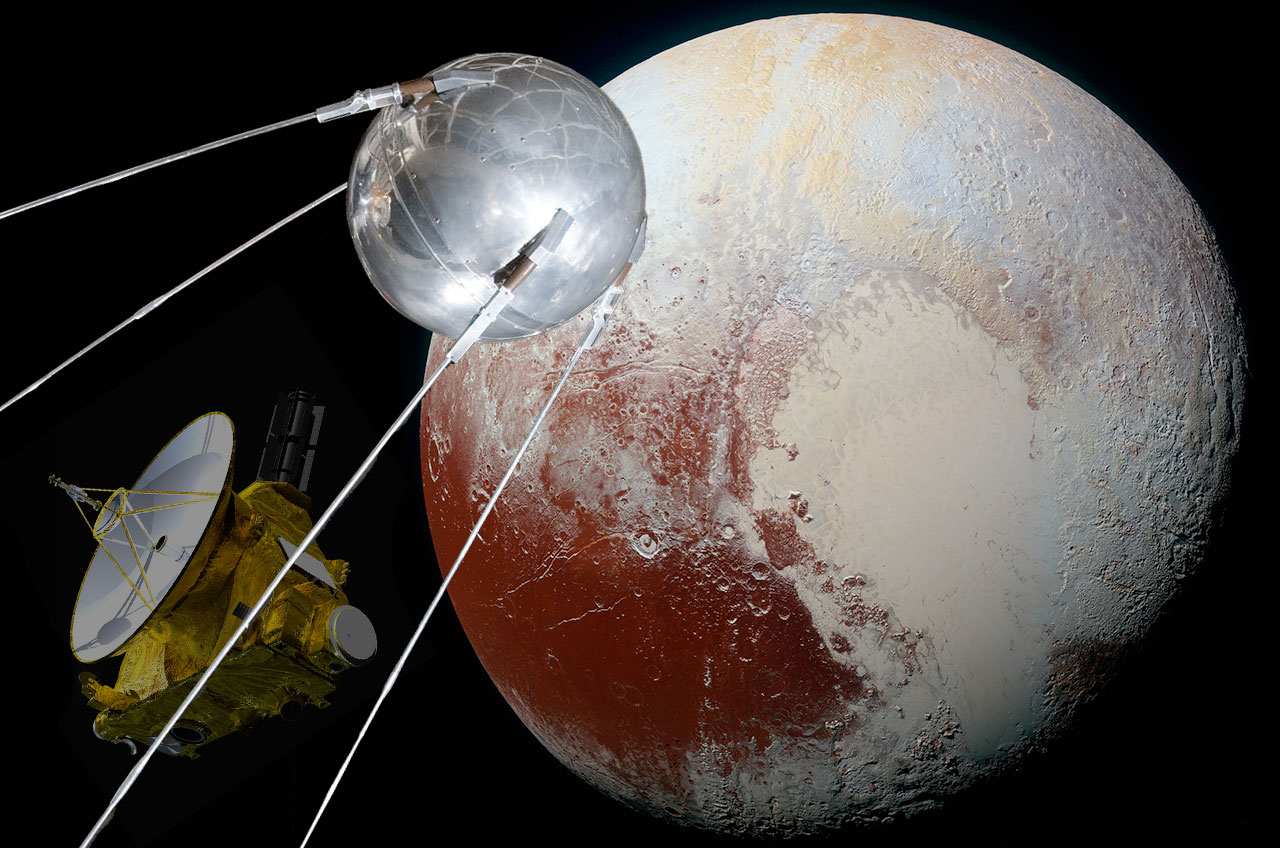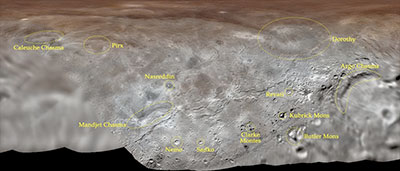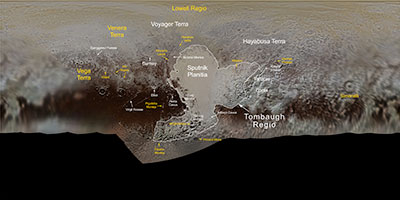|
|

|
|
Author
|
Topic: Our Pluto: Naming features on dwarf planet
|
Robert Pearlman
Editor Posts: 42981
From: Houston, TX
Registered: Nov 1999
|
 posted 03-20-2015 01:06 PM
posted 03-20-2015 01:06 PM
   
SETI Institute release Public Asked to Help Name Features on PlutoOn July 14, NASA's New Horizons spacecraft will fly past Pluto, offering the first close-up look at that small, distant world and its largest moon, Charon. These denizens of the outer solar system will be transformed from poorly seen, hazy bodies to tangible worlds with distinct features. Now, the public can help decide what labels will go on the images and maps coming from the flyby. The SETI Institute has announced the launch of its "Our Pluto" campaign, which is soliciting input on how to name features on the surfaces of Pluto and Charon.  "Pluto belongs to everyone," says New Horizon science team member Mark Showalter, a senior research scientist at the SETI Institute. "So we want everyone to be involved in making the map of this distant world." The science team will not have time to come up with names during the quick flyby, so they must assemble a library of names in advance. Consequently, they are inviting the public to visit the website ourpluto.seti.org where they can vote for the names they think should be used to identify the most prominent features on both Pluto and Charon. They can also suggest additional names. These must be associated with a set of broad themes related to mythology and the literature and history of exploration. After the campaign ends on April 7, the New Horizons team will sort through the names and submit their recommendations to the International Astronomical Union (IAU). The IAU will decide how the names are used. Currently, the best images of Pluto from the Hubble Space Telescope provide just a hint of what might be in store for the New Horizons cameras. It shows a world marked by sharp contrasts, with some areas as dark as asphalt and others as bright as snow. "The Pluto flyby this summer will be a major milestone in planetary exploration," said Alan Stern, Principal Investigator of the New Horizons project. "We are really looking forward to hearing the public's ideas for feature naming on Pluto and Charon." Showalter led the teams that used the Hubble Space Telescope to discover the two smallest known moons of Pluto, Kerberos and Styx. Those satellites were also named via a public campaign. "The difference is that last time we only needed two names, whereas now we could need more than a hundred," Showalter notes. "We are eager to gather recommendations from people all over the world." The website also includes an extremely simple ballot to allow young children to participate. |
Blackarrow
Member Posts: 3118
From: Belfast, United Kingdom
Registered: Feb 2002
|
 posted 03-20-2015 08:53 PM
posted 03-20-2015 08:53 PM
  
Clearly, the most prominent feature identified on Pluto should be named "Tombaugh." I assume that's a given. |
Robert Pearlman
Editor Posts: 42981
From: Houston, TX
Registered: Nov 1999
|
 posted 03-20-2015 09:46 PM
posted 03-20-2015 09:46 PM
   
Tombaugh is on the list of scientists and engineers — those who have contributed to our understanding of Pluto and the solar system — being considered, but is not part of the public vote. We are not collecting votes for scientists and engineers. Instead, we ask you to visit the discussion forum to learn more about these remarkable individuals. |
Robert Pearlman
Editor Posts: 42981
From: Houston, TX
Registered: Nov 1999
|
 posted 03-24-2015 11:53 AM
posted 03-24-2015 11:53 AM
   
International Astronomical Union (IAU) release Campaign for Public Participation in Naming Features on PlutoIn partnership with NASA's New Horizons mission and the SETI Institute, the IAU is endorsing a campaign that will allow the public to participate in naming newly discovered features on Pluto and its satellites. It is expected that many new features will be discovered in the upcoming flyby of Pluto and will be available for naming. The public is invited to suggest names within the designated IAU themes for these celestial bodies. Pluto retains a unique position in the hearts and minds of many. Pluto is a remote and enigmatic world that resides at the edge of the Solar System, in a region known as the Kuiper Belt, where it is one among many similar dwarf planets, although Pluto remains the largest discovered to date. On 14 July 2015, NASA's New Horizons probe will fly past Pluto, offering the first close-up look at this small, distant world and its largest satellite, Charon. These denizens of the outer Solar System will, at long last, be transformed from mysterious, hazy bodies into worlds with distinct features. In celebration of this historic occasion, the IAU is proud to endorse a campaign that will allow members of the public to participate in naming newly imaged and identified features on the surfaces of Pluto and its natural satellites. This naming campaign is a partnership between the NASA's New Horizons project, the SETI Institute and the IAU. You are invited to visit the website ourpluto.seti.org, where you can vote for the names that you think should be used to identify the most prominent features on both Pluto and Charon. You can also suggest additional names. These must be associated with a set of accepted themes set out by the IAU's Working Group for WG Planetary System Nomenclature (WGPSN) related to mythology and the literature and history of exploration: Pluto: - Names for the Underworld from the world's mythologies.
- Gods, goddesses, and dwarfs associated with the Underworld.
- Heroes and other explorers of the Underworld.
- Writers associated with Pluto and the Kuiper Belt.
- Scientists and engineers associated with Pluto and the Kuiper Belt.
Charon: - Destinations and milestones of fictional space and other exploration.
- Fictional and mythological vessels of space and other exploration.
- Fictional and mythological voyagers, travellers and explorers.
Styx: Nix: Kerberos: - Dogs from literature, mythology and history.
Hydra: - Legendary serpents and dragons.
Please note, however, that votes for other themes will not be taken into account, incl. the following, since these themes have already been used on Mercury, Venus and Mars: - Space missions and spacecraft names.
- Authors, artists, directors and producers of the fiction of exploration.
- Explorers of the Earth, air and seas.
The campaign ends on 7 April 2015, after which the New Horizons team will sort through the names and submit their recommendations to the IAU. The IAU will have the final decision on how the names are used. |
Robert Pearlman
Editor Posts: 42981
From: Houston, TX
Registered: Nov 1999
|
 posted 04-06-2015 02:15 PM
posted 04-06-2015 02:15 PM
   
NASA release NASA Extends Campaign for Public to Name Features on PlutoThe public has until Friday, April 24 to help name new features on Pluto and its orbiting satellites as they are discovered by NASA's New Horizons mission. Announced in March, the agency wants to give the worldwide public more time to participate in the agency's mission to Pluto that will make the first-ever close flyby of the dwarf planet on July 14. The campaign extension, in partnership with the International Astronomical Union (IAU) in Paris, was due to the overwhelming response from the public. "Due to increasing interest and the number of submissions we're getting, it was clear we needed to extend this public outreach activity," said Jim Green, director of NASA's Planetary Science Division at the agency's headquarters in Washington. "This campaign not only reveals the public's excitement about the mission, but helps the team, which will not have time to come up with names during the flyby, to have a ready-made library of names in advance to officially submit to the IAU." The IAU is the formal authority for naming celestial bodies. Submissions must follow a set of accepted themes and guidelines set out by the IAU's Working Group for Planetary System Nomenclature. After the campaign concludes, NASA's New Horizons team will sort through the names and submit its recommendations to the IAU. The IAU will decide whether and how the names will be used. The campaign allows the public of all ages to submit names for the many new features scientists expect to discover on Pluto following the encounter. "I'm impressed with the more than 40,000 thoughtful submissions," said Mark Showalter, scientist New Horizons science team co-investigator, and SETI Institute in Mountain View, California, which is hosting the naming website. "Every day brings new lessons in the world's history, literature and mythology. Participation has come from nearly every country on Earth, so this really is a worldwide campaign." New Horizons already has covered more than 3 billion miles since it launched on Jan. 19, 2006. Its journey has taken it past each planet's orbit, from Mars to Neptune, in record time, and now it's now in the first stage of an historic encounter with Pluto that includes long-distance imaging, as well as dust, energetic particle and solar wind measurements to characterize the space environment near Pluto. The spacecraft will pass Pluto at a speed of 31,000 mph taking thousands of images and making a wide range of science observations. At a distance of nearly 4 billion miles from Earth at flyby, it will take approximately 4.5 hours for data to reach Earth. |
Robert Pearlman
Editor Posts: 42981
From: Houston, TX
Registered: Nov 1999
|
 posted 07-07-2015 11:49 PM
posted 07-07-2015 11:49 PM
   
SETI Institute release Initial Proposal to the IAU, July 7, 2015We are pleased to announce the contents of our initial proposal to the IAU. These selections have been based on popularity in the voting, while also ensuring that the names we use in the Pluto system represent all the people of Planet Earth. If your favorite name is not on one of these lists, do not despair. We will be submitting additional names to the IAU in the future. See here for theme-by-theme listings. You can also review the entire proposal as a Google spreadsheet. |
Robert Pearlman
Editor Posts: 42981
From: Houston, TX
Registered: Nov 1999
|
 posted 09-07-2017 11:04 AM
posted 09-07-2017 11:04 AM
   
collectSPACE Sputnik satellite among official namesakes for dwarf planet Pluto surface featuresEarth's first artificial satellite, launched 60 years ago next month, journeyed only a short distance into space, but its legacy now reaches out to the farthest ends of our traditional solar system. A large plain on the surface of the dwarf planet Pluto has been officially given the name "Sputnik Planitia," after the former Soviet Union's Sputnik satellite launched on Oct. 4, 1957. The small (23 inch or 58 centimeter) polished metal sphere circled Earth in an elliptical orbit that at its farthest extended 590 miles (950 kilometers) above the planet.  |
Robert Pearlman
Editor Posts: 42981
From: Houston, TX
Registered: Nov 1999
|
 posted 04-11-2018 12:14 PM
posted 04-11-2018 12:14 PM
   
International Astronomical Union (IAU) release Pluto's Largest Moon, Charon, Gets Its First Official Feature NamesLegendary explorers and visionaries, real and fictitious, are among those immortalized by the IAU in the first set of official surface-feature names for Pluto's largest moon, Charon. The names were proposed by the New Horizons team and approved by IAU Working Group for Planetary System Nomenclature.  The International Astronomical Union (IAU), the internationally recognized authority for naming celestial bodies and their surface features, recently approved a dozen names proposed by NASA's New Horizons team, which led the first reconnaissance of Pluto and its moons in 2015 with the New Horizons spacecraft. The New Horizons team had been using many of the chosen names informally to describe the many valleys, crevices and craters discovered during the first close-up look at the surface Charon. Charon is one of the larger bodies in the Kuiper Belt, and has a wealth of geological features, as well as a collection of craters similar to those seen on most moons. These features and some of Charon's craters have now been assigned official names by the IAU. The New Horizons team was instrumental in moving the new names through approval, and included the leader of the New Horizons missions, Dr. Alan Stern, and science team members Mark Showalter — the group's chairman and liaison to the IAU — Ross Beyer, Will Grundy, William McKinnon, Jeff Moore, Cathy Olkin, Paul Schenk and Amanda Zangari. The team gathered most of their ideas during the Our Plutoonline public naming campaign in 2015. The names approved by the IAU encompass the diverse range of recommendations the team received from around the world during the Our Pluto campaign. As well as the efforts of the New Horizons team, members of the public all over the world helped to name the features of Charon by contributing their suggestions for names of the features of this far-flung moon. Honouring the epic exploration of Pluto that New Horizons accomplished, many of the feature names in the Pluto system pay homage to the spirit of human exploration, honouring travellers, explorers and scientists, pioneering journeys, and mysterious destinations. Rita Schulz, chair of the IAU Working Group for Planetary System Nomenclature, commented that "I am pleased that the features on Charon have been named with international spirit." The approved Charon names focus on the literature and mythology of exploration. They are listed here: - Argo Chasma is named for the ship sailed by Jason and the Argonauts, in the epic Latin poem Argonautica, during their quest for the Golden Fleece.
- Butler Mons honours Octavia E. Butler, the first science fiction writer to win a MacArthur fellowship, and whose Xenogenesis trilogy describes humankind's departure from Earth and subsequent return.
- Caleuche Chasma is named for the mythological ghost ship that travels the seas around the small island of Chiloé, off the coast of Chile; according to legend, the Caleuche explores the coastline collecting the dead, who then live aboard it forever.
- Clarke Montes honours Sir Arthur C. Clarke, the prolific science fiction writer and futurist whose novels and short stories (including 2001: A Space Odyssey) were imaginative depictions of space exploration.
- Dorothy Crater recognizes the protagonist in the series of children's novels, by L. Frank Baum, that follows Dorothy Gale's travels to and adventures in the magical world of Oz.
- Kubrick Mons honours film director Stanley Kubrick, whose iconic 2001: A Space Odyssey tells the story of humanity's evolution from tool-using hominids to space explorers and beyond.
- Mandjet Chasma is named for one of the boats in Egyptian mythology that carried the sun god Ra (Re) across the sky each day — making it one of the earliest mythological examples of a vessel of space travel.
- Nasreddin Crater is named for the protagonist in thousands of humorous folktales told throughout the Middle East, southern Europe and parts of Asia.
- Nemo Crater is named for the captain of the Nautilus, the submarine in Jules Verne's novels Twenty Thousand Leagues Under the Sea (1870) and The Mysterious Island (1874).
- Pirx Crater is named for the main character in a series of short stories by Stanislaw Lem, who travels between the Earth, Moon and Mars.
- Revati Crater is named for the main character in the Hindu epic narrative Mahabharata — widely regarded as the first in history (circa 400 BC) to include the concept of time travel.
- Sadko Crater recognizes the adventurer who travelled to the bottom of the sea in the medieval Russian epic Bylina.
|
Blackarrow
Member Posts: 3118
From: Belfast, United Kingdom
Registered: Feb 2002
|
 posted 04-11-2018 06:05 PM
posted 04-11-2018 06:05 PM
  
Caleuche Chasma is named for the mythological ghost ship that travels the seas around the small island of Chiloé, off the coast of Chile; No problem with the names, but it's hardly right to describe Chile's Chiloe Island as "small." With a surface area of 3,241 square miles, it is 2.3 times the size of Long Island, New York. |
Robert Pearlman
Editor Posts: 42981
From: Houston, TX
Registered: Nov 1999
|
 posted 08-09-2019 10:51 AM
posted 08-09-2019 10:51 AM
   
Johns Hopkins University Applied Physics Laboratory release International Astronomical Union Approves Second Set of Pluto Feature NamesSeveral people and missions who paved the way for the historic exploration of Pluto and the Kuiper Belt – the farthest worlds ever explored – are honored in the second set of official Pluto feature names approved by the International Astronomical Union (IAU), the international authority for naming celestial bodies and their surface features. The new names were proposed by NASA's New Horizons team, which carried out the first reconnaissance of Pluto and its moons with the New Horizons spacecraft in 2015. Along with a short list of official names the IAU had already approved, the mission science team had been using these and other place names informally to describe the many regions, mountain ranges, plains, valleys and craters discovered during the first close-up look at Pluto's surface. The IAU approved the first set of 14 feature names for Pluto in 2017, as well as a set of names for Pluto's largest moon, Charon, in 2018. The team gathered many of the naming ideas during an online campaign in 2015. The 14 newest Pluto feature names are listed alphabetically below. The names pay homage to underworld mythology, pioneering space missions that led to the capability to conduct New Horizons, historic pioneers who crossed new horizons in the exploration of Earth, and scientists and engineers associated with the study and exploration of Pluto and the Kuiper Belt.  Above: This map, compiled from images and data gathered by NASA's New Horizons spacecraft during its flight through the Pluto system in 2015, contains Pluto feature names approved by the International Astronomical Union. Names from the newest round of nominations are in yellow. (NASA/JHUAPL/SwRI/Ross Beyer) - Alcyonia Lacus, a possible frozen nitrogen lake on Pluto's surface, is named for the bottomless lake in or in the vicinity of Lerna, a region of Greece known for springs and swamps; the Alcyonian lake was one of the entrances to the underworld in Greek mythology.
- Elcano Montes is a mountain range honoring Juan Sebastián Elcano (1476–1526), the Spanish explorer who in 1522 completed the first circumnavigation of the Earth (a voyage started in 1519 by Magellan).
- Hunahpu Valles is a system of canyons named for one of the Hero Twins in Mayan mythology, who defeated the lords of the underworld in a ball game.
- Khare crater honors planetary scientist Bishun Khare (1933–2013), an expert on the chemistry of planetary atmospheres who did laboratory work leading to several seminal papers on tholins – the organic molecules that probably account for the darkest and reddest regions on Pluto.
- Kiladze crater honors Rolan Kiladze (1931–2010), the Georgian (Caucasus) astronomer who made pioneering early investigations the dynamics, astrometry and photometry of Pluto.
- Lowell Regio is a large region honoring Percival Lowell (1855–1916), the American astronomer who founded Lowell Observatory and organized a systematic search for a planet beyond Neptune.
- Mwindo Fossae is a network of long, narrow depressions named for the Nyanga (Eastern Dem. Rep. Congo/Zaire) epic hero who traveled to the underworld and after returning home became a wise and powerful king.
- Piccard Mons is a mountain and suspected cryovolcano that honors Auguste Piccard (1884–1962), a 20th century inventor and physicist best known for his pioneering balloon flights into Earth's upper atmosphere.
- Pigafetta Montes honors Antonio Pigafetta (c. 1491–c. 1531), the Italian scholar and explorer who chronicled the discoveries made during the first circumnavigation of the Earth, aboard Magellan's ships.
- Piri Rupes is a long cliff honoring Ahmed Muhiddin Piri (c. 1470–1553), also known as Piri Reis, an Ottoman navigator and cartographer known for his world map. He also drew some of the earliest existing maps of North and Central America.
- Simonelli crater honors astronomer Damon Simonelli (1959–2004), whose wide-ranging research included the formation history of Pluto.
- Wright Mons honors the Wright brothers, Orville (1871–1948) and Wilbur (1867–1912), American aviation pioneers credited with building and flying the world's first successful airplane.
- Vega Terra is a large land mass named for the Soviet Vega 1 and 2 missions, the first spacecraft to fly balloons on another planet (Venus) and to image the nucleus of a comet (1P/Halley).
- Venera Terra is named for the Venera missions sent to Venus by the Soviet Union from 1961–1984; they included the first human-made device to enter the atmosphere of another planet, to make a soft landing on another planet and to return images from another planetary surface.
| |
Contact Us | The Source for Space History & Artifacts
Copyright 2020 collectSPACE.com All rights reserved.

Ultimate Bulletin Board 5.47a
|
|

|
 advertisement advertisement

|















